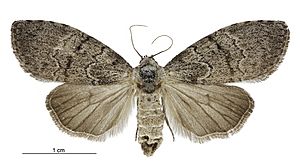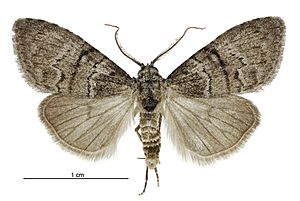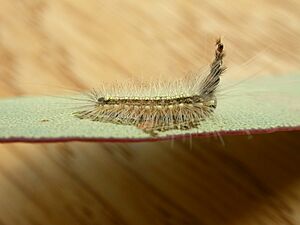Gum-leaf skeletoniser facts for kids
Quick facts for kids Gum-leaf skeletoniser |
|
|---|---|
 |
|
| Female | |
 |
|
| Male | |
| Scientific classification | |
| Kingdom: | |
| Phylum: | |
| Class: | |
| Order: | |
| Family: |
Nolidae
|
| Genus: |
Uraba
|
| Species: |
U. lugens
|
| Binomial name | |
| Uraba lugens Walker, 1866
|
|
| Synonyms | |
|
|
Uraba lugens, also known as the gum-leaf skeletoniser, is a type of moth. It belongs to the family Nolidae. You can find this moth in Australia and New Zealand.
Its caterpillars are a big problem for Eucalyptus trees and similar plants. The adult moths have a wingspan of about 25–30 mm. In Australia, these moths usually have one or two generations each year.
Contents
Meet the Mad Hatterpillar!
Uraba lugens has a really cool nickname: the mad hatterpillar. This name comes from a special thing its body does. Every time the caterpillar grows and sheds its old head, the old head part of its skin stays attached.
As the caterpillar gets bigger, it sheds larger and larger head shells. These old shells stack up on top of its head. It looks like the caterpillar is wearing a tall, funny hat!
Life Cycle of the Gum-Leaf Skeletoniser
The Uraba lugens moth goes through a typical moth life cycle. This cycle happens twice a year. One cycle is in the summer, and another is in the winter.
Female moths lay their eggs in groups. Each group can have about 100 to 200 tiny eggs. Each egg is only about 1 mm wide. When the eggs hatch, yellow caterpillars with some black marks come out. These caterpillars are the ones that eat the leaves. After the caterpillars form a cocoon and change, they become grey adult moths. During their caterpillar stage, they can chew on tree leaves and cause damage.
Why is it a Pest?
In 2001, people in New Zealand found many Uraba lugens moths in the Auckland area. By 2007, the moths had spread all over Auckland. This moth is a problem because its caterpillars eat the leaves of eucalyptus trees. When many caterpillars eat leaves, they can harm or even kill the trees.
Scientists started programs to control these moths. They looked for ways to stop them from spreading and causing more damage. One way they tried was called "biological control." This means using other living things, like natural enemies, to fight the pest.
Finding Natural Helpers
Since Uraba lugens also lives in Australia, scientists looked there for natural enemies. Australia has many insects that naturally attack Uraba lugens. These helpful insects are called parasitoids. Scientists brought some of these Australian parasitoids to New Zealand to see if they could help.
They also tested some insects that were already native to New Zealand. The idea was that using local insects would be best if they could control the moth. However, the New Zealand insects they tested did not work well enough.
Out of the Australian insects tested, one species called Cotesia urabae was the most successful. It attacked the Uraba lugens caterpillars well. It also survived and reproduced for many generations. This meant it could be a good helper in controlling the "mad hatterpillar" population.



